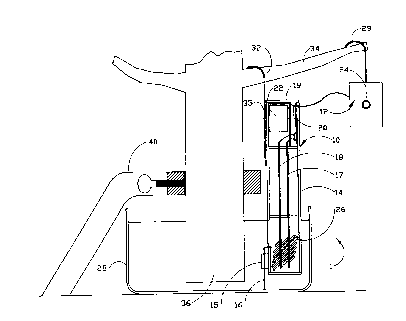Some of the information on this Web page has been provided by external sources. The Government of Canada is not responsible for the accuracy, reliability or currency of the information supplied by external sources. Users wishing to rely upon this information should consult directly with the source of the information. Content provided by external sources is not subject to official languages, privacy and accessibility requirements.
Any discrepancies in the text and image of the Claims and Abstract are due to differing posting times. Text of the Claims and Abstract are posted:
| (12) Patent Application: | (11) CA 2249090 |
|---|---|
| (54) English Title: | LOW WATER LEVEL INDICATOR |
| (54) French Title: | JAUGE DE BAS NIVEAU D'EAU |
| Status: | Deemed Abandoned and Beyond the Period of Reinstatement - Pending Response to Notice of Disregarded Communication |
| (51) International Patent Classification (IPC): |
|
|---|---|
| (72) Inventors : |
|
| (73) Owners : |
|
| (71) Applicants : |
|
| (74) Agent: | SMART & BIGGAR LP |
| (74) Associate agent: | |
| (45) Issued: | |
| (22) Filed Date: | 1998-09-29 |
| (41) Open to Public Inspection: | 2000-03-29 |
| Examination requested: | 1998-09-29 |
| Availability of licence: | N/A |
| Dedicated to the Public: | N/A |
| (25) Language of filing: | English |
| Patent Cooperation Treaty (PCT): | No |
|---|
| (30) Application Priority Data: | None |
|---|
A low water level indicator includes a detection assembly and
an indicator unit. The detection assembly comprises a housing, a
pair of electrodes, a control unit, and a battery. The indicator
unit comprises a light emitting diode (LED) and a base. The
housing is preferably molded as two halves which are joined at
assembly. An adjustment rod is held by a first and second snap
retainer at substantially the bottom of the housing. The
adjustment rod is used to adjust the height of the bottom of the
housing relative to a water container. The electronic control
circuit is mounted in a top cavity. A hook rod is held by a top
spring clip which is disposed at substantially the top of the
housing. The hook rod is used to provide stability for the
placement of the detection assembly. A second embodiment of the
low water level detector utilizes at least one eye loop projection
and a filament means to suspend the detection assembly from a tree.
When the water level in a water container is too low, electrical
current will no longer pass from the first electrode to the second
electrode through the water. When current flow ceases between the
first and second electrode, the LED will emit light until the water
level is raised.
Note: Claims are shown in the official language in which they were submitted.
Note: Descriptions are shown in the official language in which they were submitted.

2024-08-01:As part of the Next Generation Patents (NGP) transition, the Canadian Patents Database (CPD) now contains a more detailed Event History, which replicates the Event Log of our new back-office solution.
Please note that "Inactive:" events refers to events no longer in use in our new back-office solution.
For a clearer understanding of the status of the application/patent presented on this page, the site Disclaimer , as well as the definitions for Patent , Event History , Maintenance Fee and Payment History should be consulted.
| Description | Date |
|---|---|
| Inactive: IPC from MCD | 2006-03-12 |
| Inactive: IPC from MCD | 2006-03-12 |
| Inactive: IPC from MCD | 2006-03-12 |
| Application Not Reinstated by Deadline | 2002-02-27 |
| Inactive: Dead - No reply to s.30(2) Rules requisition | 2002-02-27 |
| Deemed Abandoned - Failure to Respond to Maintenance Fee Notice | 2001-10-01 |
| Inactive: Abandoned - No reply to s.30(2) Rules requisition | 2001-02-27 |
| Inactive: S.30(2) Rules - Examiner requisition | 2000-10-27 |
| Application Published (Open to Public Inspection) | 2000-03-29 |
| Inactive: Cover page published | 2000-03-28 |
| Inactive: Single transfer | 1999-02-22 |
| Classification Modified | 1998-11-30 |
| Inactive: First IPC assigned | 1998-11-30 |
| Inactive: IPC assigned | 1998-11-30 |
| Inactive: Courtesy letter - Evidence | 1998-11-17 |
| Inactive: Filing certificate - RFE (English) | 1998-11-12 |
| Filing Requirements Determined Compliant | 1998-11-12 |
| Application Received - Regular National | 1998-11-10 |
| Request for Examination Requirements Determined Compliant | 1998-09-29 |
| All Requirements for Examination Determined Compliant | 1998-09-29 |
| Abandonment Date | Reason | Reinstatement Date |
|---|---|---|
| 2001-10-01 |
The last payment was received on 2000-08-31
Note : If the full payment has not been received on or before the date indicated, a further fee may be required which may be one of the following
Please refer to the CIPO Patent Fees web page to see all current fee amounts.
| Fee Type | Anniversary Year | Due Date | Paid Date |
|---|---|---|---|
| Application fee - small | 1998-09-29 | ||
| Request for examination - small | 1998-09-29 | ||
| MF (application, 2nd anniv.) - small | 02 | 2000-09-29 | 2000-08-31 |
Note: Records showing the ownership history in alphabetical order.
| Current Owners on Record |
|---|
| THOMAS, C. KURSEL |
| Past Owners on Record |
|---|
| ROBERT E. RADKE |
| THOMAS C. KURSEL |